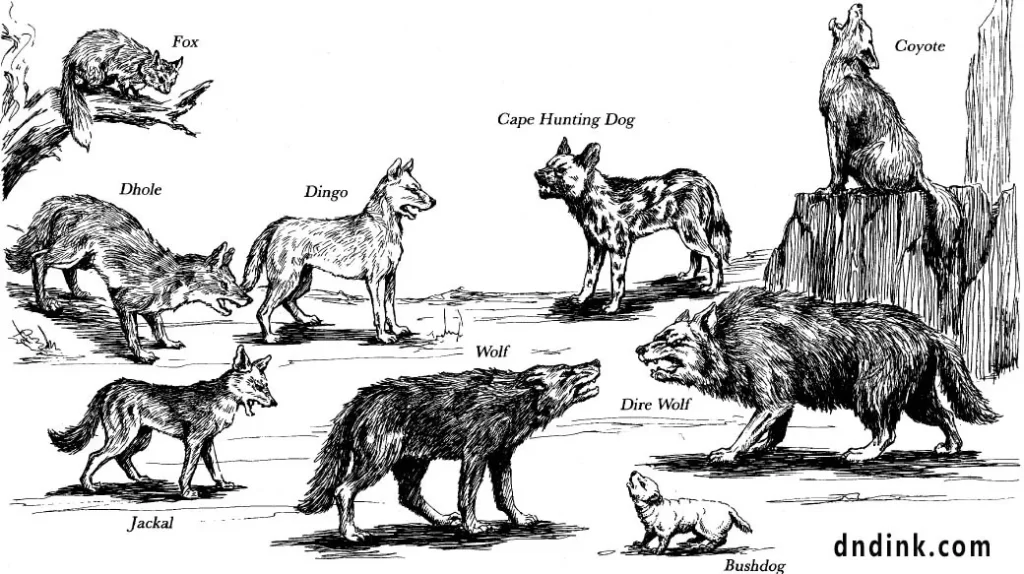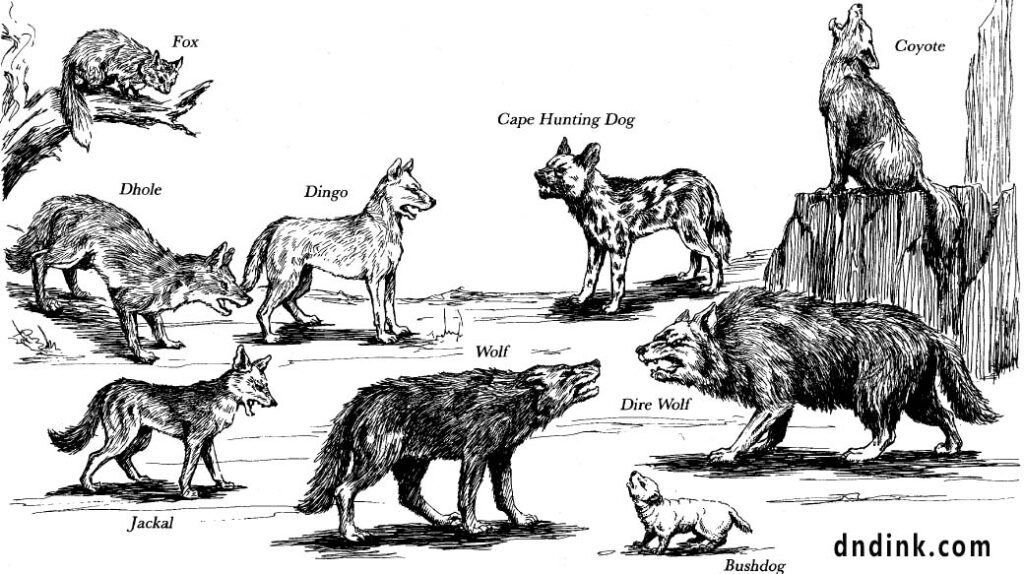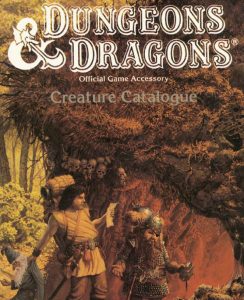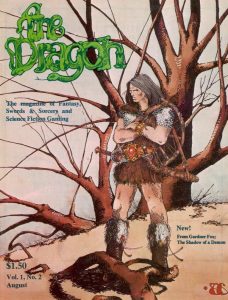
There are more dogs than you can throw a stick at, and although some of the wild canids (of the dog family such as wolves, foxes, and their kin) have been described briefly before, there are more details than ever here to consider, when wanting one as a pet.
Canids are very successful predators and are common in their native haunts. The number encountered can be highly variable, except in the case of solitary species such as the fox. In some cases two ranges are shown for number appearing, one for times and places in which prey is small or scarce (the lower number) and one for those in which prey is large and abundant (the larger number). Wolves, for instance, are found in greater numbers during the winter, when they hunt deer and moose, than in the summer, when they hunt mice and rabbits.
For instance, several otherwise separate groups of canids might gather and mingle where food is superabundant: wolves scavenging at the site of a battle, hunting dogs where large herds of animals are on the move, or foxes in a mouse-rich meadow. The largest, most numerous, and hungriest animals will have taken pos-session of the kill, and the others will dispute this or wait for an opportunity to steal or scavenge.
Canids are all at least as speedy as humans, though none of them are quite so fast as a horse or deer. It is noteworthy that canids are not slowed as much by under-growth or rough ground as humans are, so that even the stubby-legged bushdog can be a good deal faster than a man under certain conditions.
Though canids of a suitable age can be tamed, they cannot be made over into domestic dogs. They will certainly be affectionate if they are well treated but taming and training are two very different things. Solitary canids are effectively untrainable; a fox will never be more than a companion. Semi-social canids (coyotes, dingoes, and jackals) are only a little easier to handle. Like solitary canids, semi-social ones do not understand dominance and submission, and may retaliate if they are disciplined. As adults they may wander away from their handlers, just as in the wild they eventually leave their parents.

The social canids (bushdogs, dholes, feral dogs, hunting dogs, wolves, and dire wolves) can be trained as well as tamed. With the exception of feral dogs, though, they will seem aloof and indifferent by comparison with domestic dogs, and since they are less dependent on approval they are more difficult to teach. At least, though, they can be persuaded to accept their handlers and perhaps a few others as pack members, preferably senior pack members. In any case, a tamed canid will always be suspicious of new people and new things and will not adapt well to civilized life. It may seem unpredictable because it does not always understand human signals and because wild canids are often difficult to "read." These misunderstandings may have tragic results.
Coyotes, dingoes, wolves, and jackals are all fertile with domestic or feral dogs and with each other, though they do not normally interbreed. The offspring, themselves fertile, are intermediate in most characteristics, though from a human point of view crosses of domestic with wild canids look and act "wild" and present the training problems, being difficult to train and seemingly unpredictable. A dog-wolf cross, for instance, inherits the wolfs aloofness and hostility toward strangers, and this, along with its large size and powerful jaws, might suggest that it would be a good guard dog. However, it shows a wolfs reluctance to bark, and it may show wolflike caution and simply avoid an intruder rather than risk an attack.
Canids of all sorts have very keen senses of smell and hearing. In good light, a canid's sense of sight is less exceptional, since canids do not perceive colors and haven't the sharpness of vision that humans have. However, a canid can see about as well by moonlight as by daylight and can see as well on a moonless night as a human would under a full bright moon.
Canids are opportunists, and will eat practically anything: fresh meat, carrion, fruit, insects, and even some roots and grasses, including what humans would regard as garbage. Dholes, hunting dogs, and bushdogs are more exclusively predacious than the others, while foxes are best described as omnivores with a preference for meat. The others fall somewhere in between, with the larger and more social sorts showing a greater preference for hunting. Even the largest canid is cautious and will seldom attack an animal of its own size or larger that fights back. A wound can be fatal, even for an individual that is supported by the rest of the pack; the animal may well starve before it recovers, even living on "charity." This doesn't mean that hunting canids will leave humans and their domestic animals in peace, however. They may test them to see if they are able to run away or defend themselves, and if they uncover weakness they will exploit it.
How-ever, humans are not on any canid's "preferred" list. They are too likely to have nasty surprises on hand, such as swords and spears, and after centuries of association canids know this instinctively. Unless they are starving and desperate, they will avoid humans entirely.
Bushdog
A bushdog is a small brownish canid of robust build, covered with coarse, sparse hair. It has a short, broad skull, powerful jaws, short legs, small ears, and a short tail, and looks somewhat like a heavily built dachshund, or a cross between an otter and a small dog. With their low-slung bodies and webbed feet, bushdogs are well suited to the heavy undergrowth and abundant water of their native haunts. They live in small packs and communicate using various whistles, clicks, chirps, and squeals. When excited, they give voice to high-pitched, metallic barks. Bushdogs regard nearly anything of suitable size as prey, and will pursue large water rodents, small deer, and birds up to the size of a rhea as well as lesser game. Young bushdogs are not difficult to tame and train. Their expressive faces make their moods as easy to read as those of dogs and wolves, making the task an easy one. Tame bushdogs are affection-ate and gentle as they are homely. Bushdogs are tropical, living in the forest or near water and away from settled areas.
Coyote
This is a versatile, mid-sized predator, able to take prey as large as sheep or goats, although coyotes generally restrict themselves to less difficult foods, such as mice and berries. The typical coyote is greyish, with long fur and long legs. Coyotes are wary and difficult to catch; they are less odorous than foxes and therefore more difficult to track, and over long distances they can outpace the fastest coursing hounds. Semi-social, coyotes can be tamed but not trained. They may be found in any climate from subarctic to subtropical and in any sort of terrain, even invading the mountainous parts of the tropics. They thrive in both settled and domestic areas.
Dhole
The dhole, or red dog, resembles a domestic mongrel at first glance, but it carries its bushy tail low and has reddish fur, short legs, and a short muzzle that has a unique profile: the line from skull top to nose tip is convex rather than concave. Dholes hunt in large, highly cooperative packs, and they chatter when they are ex-cited (they seldom bark). Aggressive and bold, they will attack even the largest herbivores, though they prefer deer-sized game. They have been known to drive away or kill competing predators, including tigers. Dholes trot tirelessly after their chosen prey, following it until it weakens and is suddenly vulnerable to a sudden coordinated rush. What they lack in sprinting speed, dholes make up for in endurance. Unlike other canids they are fond of water; it is difficult to escape them. Dholes hunt by day, or on moonlit nights. Dholes show little fear of humans but are not known to attack them either. They can be tamed if captured when young but are perhaps more difficult to handle than some other social canids might be because of their relatively inexpressive faces. Dholes live in both the forest and the steppe in temperate to subarctic climes. They survive in both settled and wilderness areas.
Dingo
Though they are like coyotes in size, build, and habits, dingoes are de-scended from or closely related to domestic dogs. Evidence of domestic ancestry is to be found in dingo coat colors and patterns, which (in addition to the nondescript tawny color typical of wild dogs) range through black, red, white, yellow, brown, and pie-bald, though none of these is as common as the "wild" type. Like coyotes, dingoes may be found in any sort of terrain, but they range from tropical to temperate climes rather than from subtropical to subarctic. They will not occur together with coyotes. Dingoes are semi-social. They can be tamed but not trained.
Feral Dog
This type is not truly a wild canid. Feral dogs are domestic dogs that have spent a generation or more away from human interference. Natural selection tends to produce an animal midway in size between coyote and wolf, and features such as droopy ears, odd coloration, gigantism, dwarfism, and so on become less common with each generation. Feral dogs do not occur together with truly wild canids of the same size, since they can't compete, especially where seasons are marked. Like domestic dogs, feral dogs may bear young at any time of the year, including such inappropriate times as the middle of the winter or the height of the flood season. Feral dogs will be found in most climes and sorts of terrain, but only within 50 miles of human settlements. They can be tamed if captured young and are in effect domestic dogs.
Fox
Foxes and foxlike canids of various sorts are found everywhere, from the high arctic, to the deep tropical rain forest. Except when rearing their pups, they are solitary, and they are generally nocturnal. They catch game of pheasant size or less, and feed on whatever else is available. Most kinds are unobtrusive and wily enough to survive in settled areas despite organized persecution. Being asocial creatures, foxes can be tamed but not trained.
Hunting Dog
Also called the African hunting dog or Cape hunting dog, this canid is not closely related to the others. It resembles a big domestic dog with long legs, an outsize head, powerful jaws, and large, rounded ears. The short fur is sparse, and he black skin beneath it can be seen in places. Hunting dogs sport a peculiar harlequin pattern: asymmetrical white blotches, rimmed with black, on a yellowish background. The tip of the tail is always white, and the face and muzzle black. Hunting dogs have a strong, musky odor. They are efficient hunters and can bring down any-thing smaller than an elephant or a hippopotamus, hunting in coordinated groups near sunrise or sunset. They chatter when excited, and make a strange, bell-like sound in the chase. Members of the pack are very close, and it is surprising that these canids are not more often tamed. Their inexpressive faces and strong odor may have some-thing to do with this. They can be tamed and trained for use as coursing hounds, though. Hunting dogs seldom attack humans but will take domestic animals. They are native to open tropical country.
Jackal
Jackals (there are several species) are like coyotes in appearance and behavior, though they are smaller. They catch game up to the size of a gazelle or lamb but generally eat smaller animals or scavenge, hunting cooperatively only on occasion. They are semi-social, like coyotes. Jackals are found in warm temperate or tropical climates in any sort of terrain except heavy forest.
Wolf
Wolves are the largest modern canids. They vary in appearance from place to place, both in size and in color. Wolves vary from white through greys, browns, and red-browns to black. The larger races tend to specialize in larger prey, but any sort will take prey of mouse-size to moose-size. As with other canids, wolves (with the exception of rabid individuals) usually leave humans alone, though they are less circumspect (unwilling) when it comes to domestic animals. They may pick up scraps or stray animals. During time of war, wolf populations tend to grow, for wolves will not pass up carrion. Since they are closely akin to domestic dogs and they are social carnivores, wolves are perhaps the easiest to tame and train of the wild canids. However, they need to be kept under strict supervision, especially when they reach maturity at two years of age. At that time they may try to take over leadership in their adoptive "pack." Wolves are found in arctic to subtropical climates, in any sort of climate but the driest desert. In settled areas, wolves will be rare or nonexistent. In arctic and subarctic climates, wolves may grow quite large.
Dire Wolf
Dire wolves are wolflike canids that resemble wolves in most aspects, but prey on larger animals and are more partial to carrion. The dire wolf looks much like an ordinary wolf, but is more heavily built, has proportionately shorter legs, and has larger teeth and more powerful jaws. A dire wolf is less intelligent than an ordinary wolf, though still within the semi-intelligent range. Dire wolves can be tamed and trained, but the handler is in grave danger should he make a miscalculation. Dire wolves are found in the same sorts of environments that wolves are, wherever large prey species are available.






